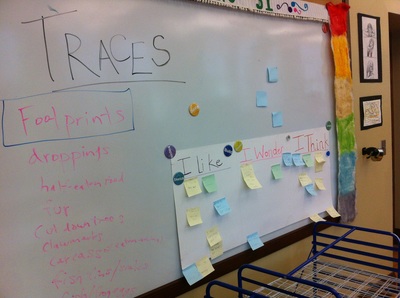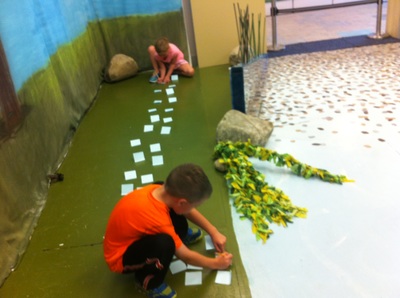|
Day two was a long but fulfilling one! The morning kicked off with a series of planning meetings with the education committee for the project and prep for our afternoon class. I got to spend a few hours with two of the performers, Jess and Dusty, in the exhibit space with live visitors bustling around us. For the last two months since the exhibit opened, I have been communicating with the performers through a google doc reflection sheet they fill out following each 2 hour performance session as well as photo and videos of their work. We began the project with 6 performers, all Playguides from the museum staff. We were lucky to have the addition of an actor from Brookings who expressed interest in the project for July and August. Though we had a full day of performer training in June and another in July, it was not enough to fully prepare the group for the intensity and unexpected turns of improvising live with children and families for 2 hours a day. Though I was very curious about training non-performers to lead engaging performance segments and further play and inquiry, I have learned a lot about supporting this process and what I might do in future projects. My morning with the performers was really interesting. It began by observing their interactions in the space. I have spent so much time suggesting and coaching the kinds of interactions the space requires from performers but today required further action. I grabbed an extra costume piece and jumped in! Not only was it fun to demonstrate child-led investigations of the space to the performers but an essential way to train them in supporting their partner's risk-taking. With three performers in the space we could position ourselves in different areas and focus on subject matter of interest to each child. So far in the project, performers have felt most comfortable doing a specific game in the enclosed pond area of the exhibit. Following our live rehearsal, we brainstormed a number of storylines to follow that do not rely on a specific character from performers and use a child's curiosity and problem-solving skills to get information already in the space. For instance, our performers do not speak in full sentences. They use single words to communicate their most central needs. "Home?" they might ask a child. A girl I engaged with today, found a rabbit and repeated back to me "home?". "Nest!" and began to build a nest for the rabbit. "Family?" she asked me. "Hmmm", I looked around. "Search". "Babies," she cried out as the rabbit puppet searched for baby rabbits. Our game continued until we sucessfully found three baby rabbits and sufficient leaves to feed our family. "Happy", she finally said. Performers and I also worked on some puppet handling skills. I have been watching videos of them handling multiple animals at once, in view of children and casually discarding them at will. We worked on moving puppets at different body points, exploring levels and keeping performer focus on the puppet. Having them use puppets as extensions of their own bodies and emoting along with puppets seemed to make a world of difference in their connections to the performance pieces. Finally, this afternoon marked another class session with the CMSD Mixed Media students, a group of 6-9 year olds who built the original model diagram for our A Stream to Ponder exhibit space. We stuck to their design as closely as possible and utilized their ideas in other areas of the project's research. Today we explored animal traces or evidence left behind by animals in the habitat. The group examined animal footprints and designed stamps cut from sponges to add to the exhibit space. In partners students had to choose a native SD animal, study its footprints and stride patterns, design a footprint (front and hind legs) and cut a sponge stamp. The group then laid down post-it notes to show where the animal came from and was going to next. They told the rest of the group the story behind the animal's path and following the class, the footprints were added to the exhibit.
Some photos:
1 Comment
Day one of the CMSD August residency involved puppets. LOTS of them! 97 puppets to be exact, in 2 hours...I love making puppets with young people because they can be wildly sucessful using a variety of materials and puppet styles for little ones all the way down to toddlers. We took over CMSD's art studio and filled tables with tons of colorful supplies to inspire 3D puppets that might live in a pond or stream habitat. As part of our ongoing research into children's inquiry about pond/stream habitats, each child was invited into the exhibit space to find the ideal home for their puppet creature. "Why did you choose this location?", I asked. Children gave lots of reasons for their choices including safety, proximity to food sources and beautiful natural sights. I shot a photo of each child with their puppet in their home and asked each puppets' name. Above is a baby trout named "fish" by a four year old friend. Tomorrow is a day full of observation in the space and working with performer to deepen engagement in the space through prop play and creative drama. Lets do it!
Happy to be back in Brookings, SD for my fifth and possibly final residency period at Children's Museum of South Dakota and our collaborative project, A Stream to PONDer. The exhibit will be open through December 2015 but this is my last scheduled residency on-site and we have puppet making workshops, rehearsals with the performers, a mixed media class with our youth liaisons (group of 6-9 year olds who have been integral to project from its inception) and a visitor workshop on animal traces. I'm feeling a bit nostalgic on this visit as I think back to how this project got started a year ago when I cold-called CMSD to pitch them a project. "Do you have 10 minutes to chat about an exciting interactive project opportunity?"- said the script notes I wrote down before the call in case I froze and forgot what to say. At the time I fully realized how much my pitch sounded like a telemarketer's spiel trying to sell long distance service but had zero luck connecting to anyone via email. At the time, I was committed to my future as a full-time project-based artist and decided the only way to sell someone idea was to hold their attention live, on a phone call. "Sure, I have 10 minutes", Carrie Benson, CMSD Director of Education said. Whoa. Wow, i'm on. I remember my voice going dry in the middle of sentences and consciously reminding myself to slow down. "You know what I mean?" I'd throw in every once in a while just to be sure she was still on the line. After minutes of emphasizing words like "hands-on investigation" and "inquiry-based performance techniques" I was convinced Carrie was not interested and I wasted my time. "Could you send me some grant options to fund a project like this?" she asked and the rest is history. Soon I was on my way to SD for the first time in February to meet a courageous team of museum staff, my partners in research and design of a new, evolving exhibit based on ecological habitats found in South Dakota.
More reflection in the next post |
|














 RSS Feed
RSS Feed